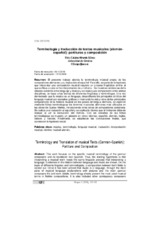Mostrar el registro sencillo del ítem
Terminología y traducción de textos musicales (alemánespañol): partituras y composición
| dc.contributor.author | Miranda Gálvez, Silvia Catalina | |
| dc.date.accessioned | 2018-06-19T11:07:29Z | |
| dc.date.available | 2018-06-19T11:07:29Z | |
| dc.date.issued | 2017 | |
| dc.identifier.issn | 2255-3703 | |
| dc.identifier.uri | http://hdl.handle.net/10396/16971 | |
| dc.description.abstract | El presente trabajo aborda la terminología músical propia de los compositores alemanes y su traducción al español. Para ello, se parte de la hipótesis que interpretar una composición musical requiere un proceso lingüístico similar al que se lleva a cabo en la interpretación de un idioma. Se muestran evidencias de la relación existente entre lenguaje y música y se realiza una comparación entre ambas disciplinas, en base a las teorías de diferentes lingüístas y terminólogos. Una vez demostrado que la música es un lenguaje, desarollando los principales ámbitos del lenguaje musical con ejemplos gráficos y mostrando la vida y obra de los principales compositores de la historia musical en los países de lengua alemana, se exponen mediante fichas terminológicas los términos musicales alemanes más utilizados en las obras de Gustav Mahler, introduciendo otras obras de compositores coetáneos. Se realiza una traducción al español y se explica la técnica que el intérprete debe de realizar al ver la instrucción del término. Con las entradas de las fichas terminológicas se muestra un glosario en cinco idiomas: español, alemán, inglés, italiano y francés. Finalmente, se establecen las conclusiones finales, que corroboran la hipótesis inicial. | es_ES |
| dc.description.abstract | This work focuses on the specific musical terminology of the german composers and its translation into Spanish. Thus, the starting hypothesis is that interpreting a musical work needs the same linguistic process that interpreting a language. Evidences of the relation between language and music are shown. On the basis of differents linguists and terminologists, a comparation between both fields is carried out. Once it has been proved that music is a language, through the main parts of musical language explanations with pictures and the main german composers life and work details, terminology sheets present the most used musical terms in Mahler compositions. It is also included other comteporary composers pieces. A spanish translation is carried out and it is explained the tecnique that the musical interpreter must play due to a specific musical term. Using the same terms, it is shown a glosary in five differents languages: spanish, german, english, italian and french. According to the final conclusions establised, the starting hypothesis is confirmed. | es_ES |
| dc.format.mimetype | application/pdf | es_ES |
| dc.language.iso | spa | es_ES |
| dc.publisher | UCOPress | es_ES |
| dc.rights | https://creativecommons.org/licenses/by/3.0/ | es_ES |
| dc.source | Skopos 8, 127-152 (2017) | es_ES |
| dc.subject | Música | es_ES |
| dc.subject | Terminología | es_ES |
| dc.subject | Lenguaje musical | es_ES |
| dc.subject | Traducción | es_ES |
| dc.subject | Interpretación musical | es_ES |
| dc.subject | Término musical alemán | es_ES |
| dc.subject | Music | es_ES |
| dc.subject | Terminology | es_ES |
| dc.subject | Musical theory | es_ES |
| dc.subject | Translation | es_ES |
| dc.subject | Musical interpretation | es_ES |
| dc.subject | German musical term | es_ES |
| dc.title | Terminología y traducción de textos musicales (alemánespañol): partituras y composición | es_ES |
| dc.title.alternative | Terminology and Translation of musical Texts (German-Spanish): Partiture and Composition | en |
| dc.type | info:eu-repo/semantics/article | es_ES |
| dc.relation.publisherversion | https://www.uco.es/ucopress/ojs/index.php/skopos/index | es_ES |
| dc.rights.accessRights | info:eu-repo/semantics/openAccess | es_ES |

